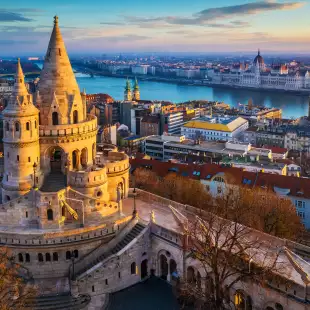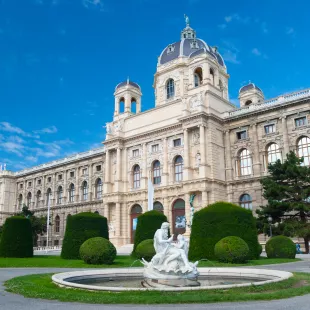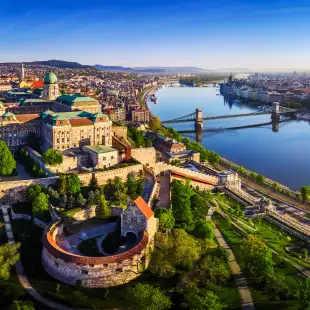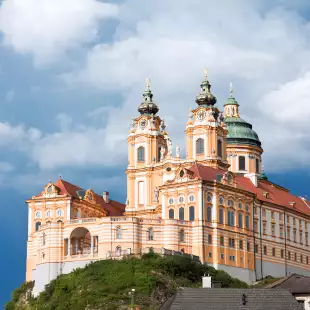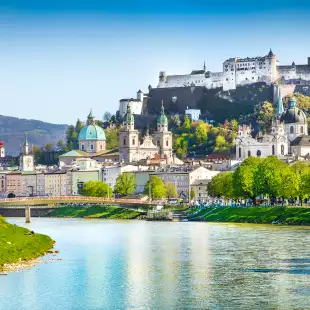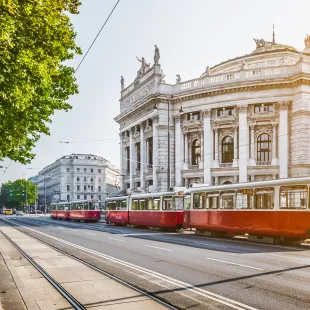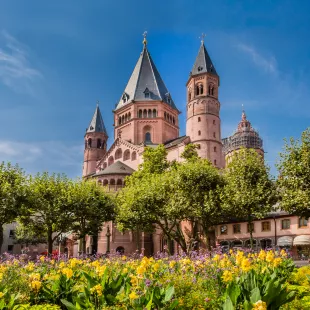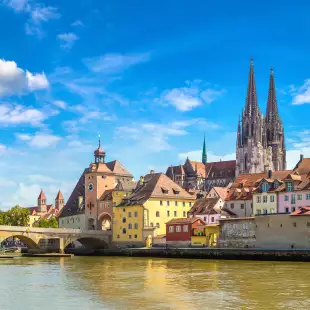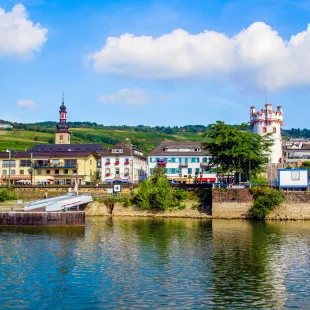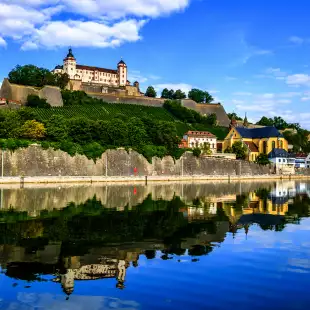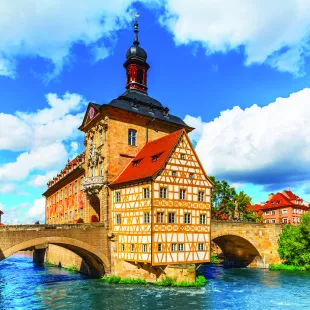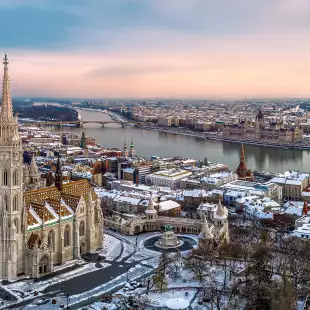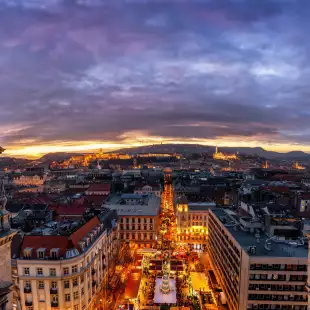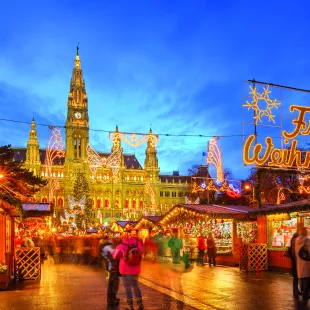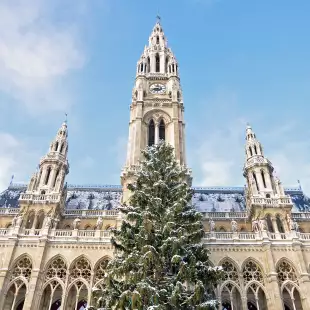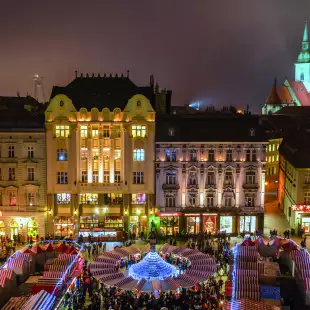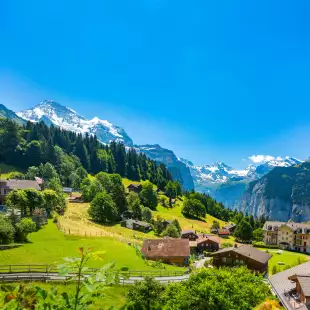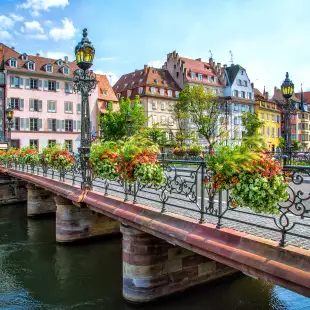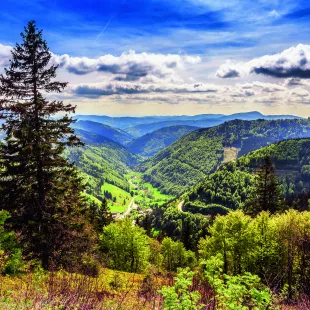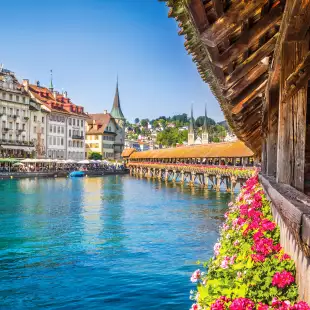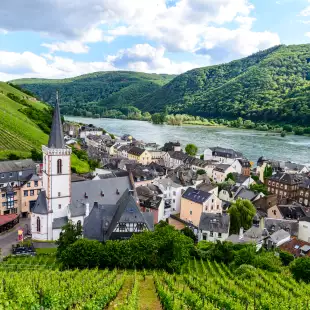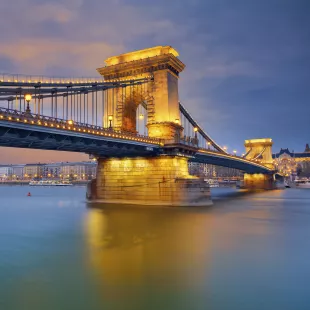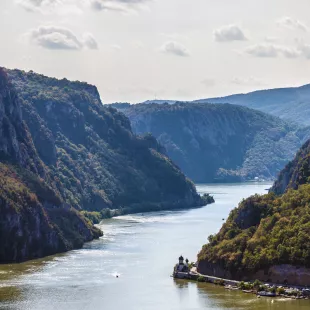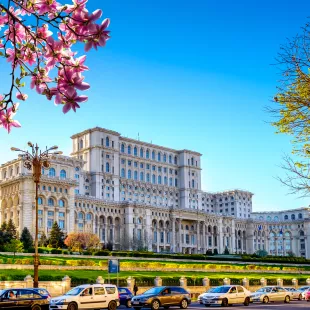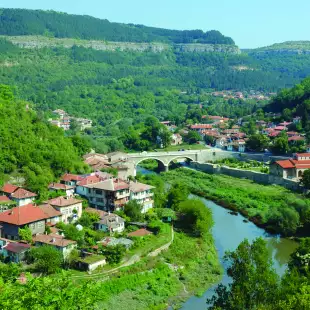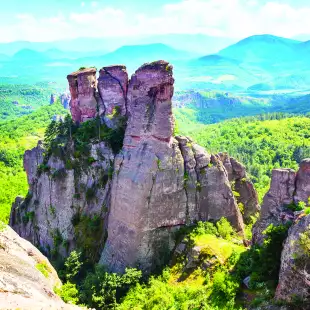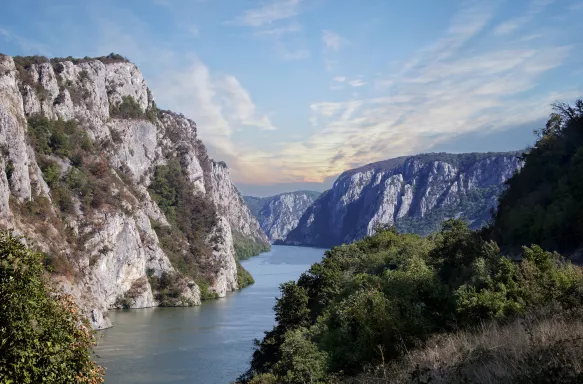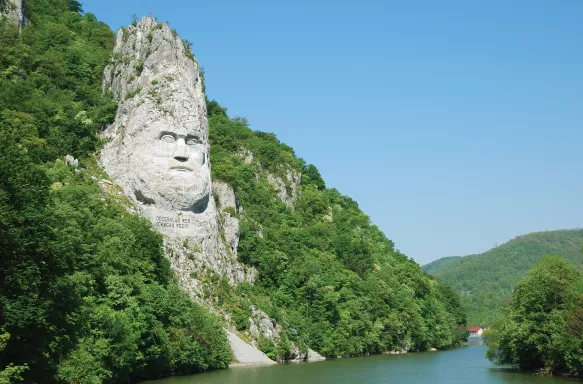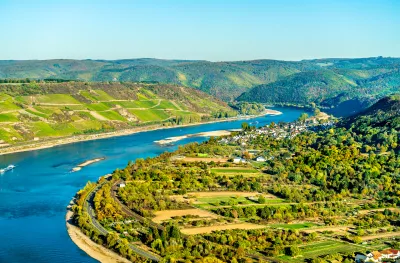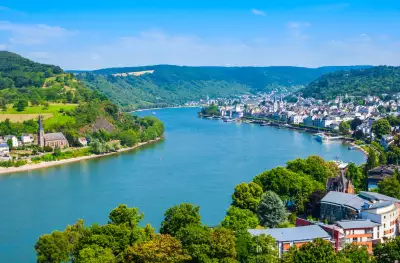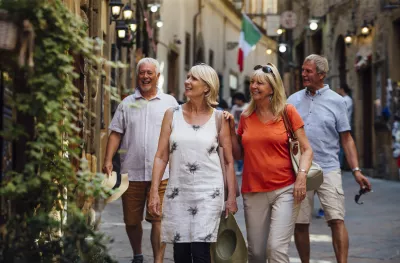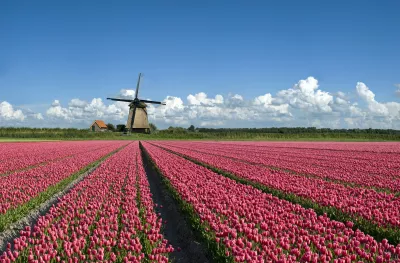Top 10 Highlights on a Danube River Cruise: Europe's Majestic Waterway
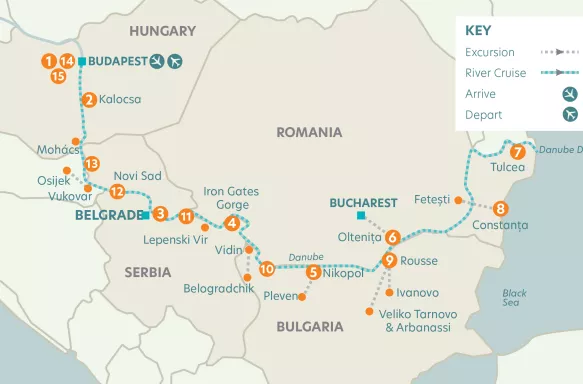
Flowing through ten countries, the Danube River is one of Europe’s most captivating waterways, stretching from Germany’s Black Forest to the Black Sea. A Danube river cruise offers an unforgettable journey through breathtaking landscapes and centuries of history — perfect for travellers seeking the best European river cruise experience.
Along the way, explore five of Europe’s most iconic capital cities — Vienna, Bratislava, Budapest, Belgrade, and Bucharest — each brimming with culture, architecture, and charm. Discover storybook towns, grand palaces, and UNESCO-listed landmarks as you uncover the magic of this remarkable European river cruise route.
Curious about the best sights along the Danube cruise? View our interactive map of the Danube River to find the must-see destinations and our favourite stops along the way

Places To Visit On The Danube River:
The Black Forest
The Danube River begins its journey on the western slopes of Germany’s enchanting Black Forest, one of Europe’s most scenic and storied regions. Here, near the charming town of Donaueschingen, two small streams — the Brigach and the Breg — meet to form the mighty Danube, which then winds its way through the heart of Central Europe toward the Black Sea.
Travellers on a Danube river cruise can trace this remarkable river’s origins and soak up the dramatic beauty of the Black Forest Mountains — a landscape of pine-covered hills, crystal-clear streams, and fairytale villages.
For those seeking even more spectacular scenery, extend your journey on a Rhine Cruise to Switzerland, where rugged mountain vistas and elegant riverside towns complete your best European river cruise adventure.
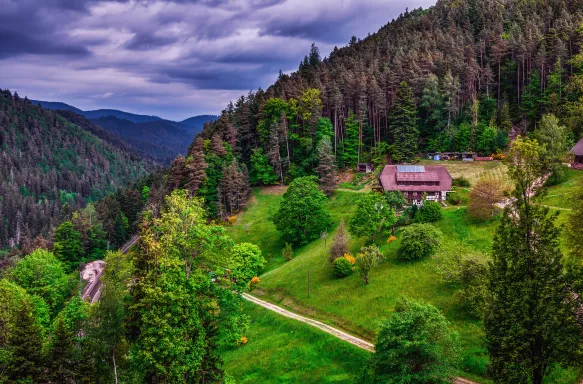
Linz
Nestled directly on the Danube River, Linz was once a bustling hub of medieval trade and craftsmanship. Today, this dynamic Austrian city has transformed into a thriving centre of art, culture, and technology, offering a fascinating mix of old and new for travellers on a Danube river cruise.
Designated a UNESCO City of Media Arts, Linz celebrates creativity at every turn. Explore the city’s acclaimed museums — including the Castle Museum, which houses an exceptional collection of 19th- and 20th-century artworks inside a 17th-century castle built by Emperor Rudolf II.
As you wander through Linz’s charming streets, you’ll discover Baroque architecture, historic landmarks, and the graceful Old Town, home to the Monastery of the Friars Minor, now the seat of the Upper Austrian Provincial Government.
At the city’s heart lies one of Europe’s largest and most beautiful urban squares. Lined with elegant pastel façades, Hauptplatz Square is crowned by the striking Trinity Column, carved from white marble — a picture-perfect highlight of any European river cruise itinerary and a must-see stop on the best Danube river cruises.
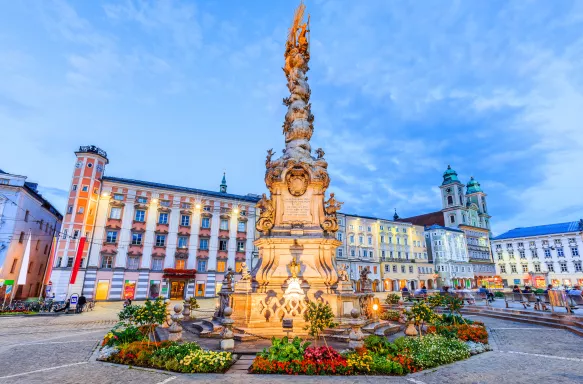
Salzburg
Although not situated directly on the Danube River, Salzburg is an easy and rewarding excursion from many Danube river cruises. A jewel of Baroque Europe, this UNESCO World Heritage Site is celebrated for its remarkable preservation and cultural heritage, which spans from the Middle Ages to the 19th century, when Salzburg flourished as a city-state ruled by a powerful prince-archbishop.
Nicknamed the “Rome of the North,” Salzburg was once the largest ecclesiastical state outside the Vatican, governed by a prince-archbishop who held the same privileges as the Pope. The city’s sacred and secular buildings — from grand cathedrals to ornate palaces — remain beautifully intact, offering travellers on a European river cruise a glimpse into centuries of art, music, and faith.
No visit to Salzburg would be complete without celebrating its most famous son, Wolfgang Amadeus Mozart. Stroll through the Old Town, where you can tour Mozart’s birthplace, visit the Mozarteum Foundation, and pay your respects to his family at St Sebastian’s Cemetery. In the heart of the city, the Mozart Monument stands as a timeless tribute to the composer’s genius — an essential stop on any itinerary that aspires to be the best European river cruise experience.
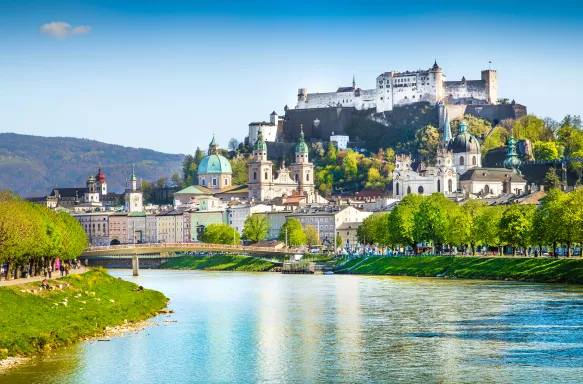
Melk & Benedictine Abbey
Perched above the Danube River at the entrance to Austria’s Wachau Valley, the town of Melk began life as a Roman fort before blossoming into one of the most beautiful stops on any Danube river cruise. Its crowning jewel, the magnificent Melk Abbey, is instantly recognisable for its honey-coloured façade and commanding hilltop setting.
Originally built as a castle, the site was gifted to the Benedictine Order in the 11th century and has remained a centre of monastic life and learning ever since. The abbey you see today, reconstructed in glorious Baroque style, is a masterpiece of art and architecture. Inside, visitors can marvel at the portrait-lined Emperor’s Gallery, the richly decorated ceremonial rooms, and an ornate library containing around 80,000 historic manuscripts. The abbey church glows with gilded frescoes and altarpieces by renowned Baroque masters, while its manicured gardens offer a peaceful retreat with sweeping river views.
After exploring the abbey, wander into Melk’s charming Old Town, where narrow cobbled streets are lined with cosy cafés, boutique shops, and inviting restaurants — the perfect spot to relax and watch the world drift by on your European river cruise.
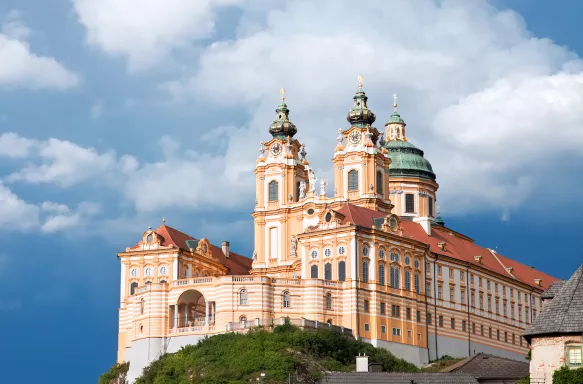
Spend the morning exploring this extraordinary building on our Cruise the Heart of Europe river cruise, with additional stops along the Danube in Vienna, Bratislava and Budapest.
Dürnstein
Clinging to the north bank of the Danube River in Lower Austria, the storybook town of Dürnstein is one of the most charming stops on any Danube river cruise. Instantly recognisable by the striking sky-blue tower of its abbey, Dürnstein also holds a fascinating place in history as the site where Richard the Lionheart was famously imprisoned by Duke Leopold V of Austria.
Although the medieval castle now lies in atmospheric ruins, it’s well worth the climb for breathtaking panoramic views of the river, town, and surrounding vineyards. The trail winds gently through the vines, making it a rewarding stop for travellers seeking to experience the heart of the Wachau Valley.
Situated in the centre of Austria’s celebrated Wachau wine region, Dürnstein is surrounded by vineyards in every direction. Sample the area’s world-class wines at a local cellar — the crisp, aromatic Rieslings are a particular highlight. And for a taste of the region’s sweetest tradition, don’t miss Dürnstein’s apricot specialities: try the delicate apricot dumplings, golden strudel, or smooth apricot brandy.
Whether you’re exploring its cobbled streets, sampling local flavours, or simply admiring the view from the river, Dürnstein captures everything that makes a European river cruise along the Danube one of the most memorable travel experiences in Europe.
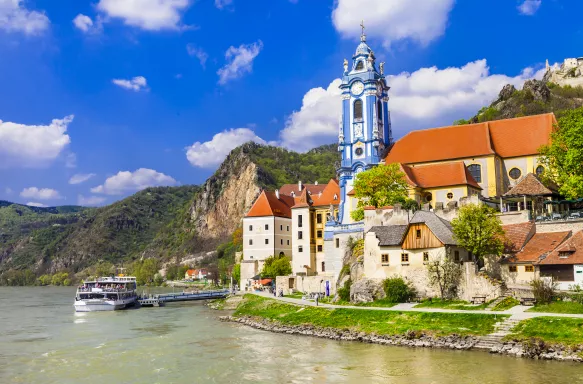
Vienna & Schönbrunn Palace
Vienna
Set gracefully on the banks of the Danube River, Vienna — Austria’s majestic capital — is a highlight of any Danube river cruise. Blending imperial grandeur with timeless charm, Vienna evokes images of elegant palaces, classical music, and café-lined boulevards. Once the cultural center of Europe, the city’s magnificent Baroque architecture and grand public buildings still reflect its imperial past as the seat of the Habsburg Empire.
The skyline is dominated by the colorful tiled roof and soaring Gothic South Tower of St. Stephen’s Cathedral, one of Vienna’s most iconic landmarks. Equally unmissable is the Hofburg Palace, the vast former residence of the Habsburg dynasty. This sprawling complex — among the largest palace ensembles in the world — invites visitors to step back into royal history. Explore the lavish Imperial Apartments and staterooms, wander through the fascinating Sisi Museum, and admire the dazzling Imperial Silver Collection.
The Hofburg is also home to the world-famous Spanish Riding School, where the graceful Lipizzaner stallions perform with unmatched elegance. Travelers can attend morning training sessions, intimate demonstrations, or full performances — a truly unforgettable experience for anyone seeking the best European river cruise itinerary.
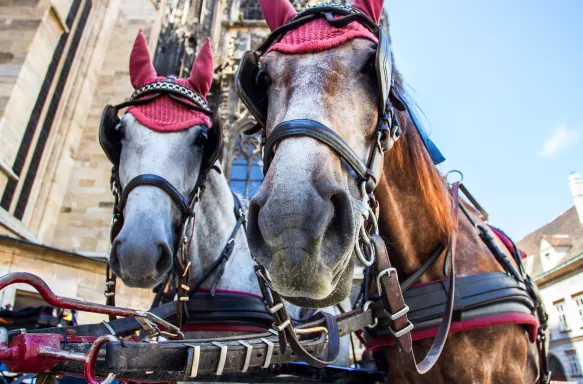
Schönbrunn Palace
The magnificent Schönbrunn Palace stands as a lasting symbol of the power and influence of the House of Habsburg from the 17th to the early 20th century. Once the summer residence of Austria’s imperial family, this grand palace is now a tranquil oasis in the heart of modern Vienna — and an essential highlight for travelers on a Danube river cruise.
Visitors can step into history by touring 40 of the palace’s most spectacular rooms, walking in the footsteps of emperors, empresses, and world-famous figures such as Napoleon and Mozart. The estate also features several fascinating museums, including the Carriage Museum, displaying ornate coaches, sedan chairs, and royal vehicles once used by the imperial family, as well as a Children’s Museum that offers a glimpse into the lives of the Habsburg princes and princesses.
Designated a UNESCO World Heritage Site, the Palace and Gardens of Schönbrunn are celebrated as one of Europe’s most impressive and best-preserved Baroque ensembles. The gardens are a breathtaking blend of art and nature, stretching across more than a square kilometer of tree-lined paths, flowerbeds, and wooded walks. Scattered throughout are fountains, statues, and decorative follies — each reflecting the grandeur of imperial Vienna. To the east, the elegant Orangery extends 186 meters, making it the longest of its kind in the world.
For anyone seeking the best European river cruise, a visit to Schönbrunn Palace perfectly captures Vienna’s imperial spirit and timeless beauty.
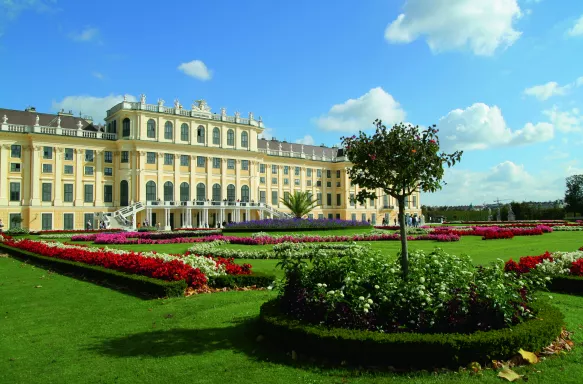
Bratislava
Bratislava straddles the Danube River, gracefully spanning both banks in the southwest corner of Slovakia. Once marked by the uniformity of the Communist era, this vibrant capital has rediscovered its imperial charm, showcasing a beautiful mix of architectural styles — from medieval and Gothic landmarks to Baroque palaces and a Renaissance-restored castle overlooking the city.
Compact yet full of character, Bratislava is perfect for shopping, dining, and exploring. In the Old Town, cobblestone streets weave between pastel façades, leafy squares, and elegant fountains. Dominating the skyline are St. Martin’s Cathedral and the hilltop Bratislava Castle, offering sweeping views of the Danube River — a highlight for travelers on a Danube river cruise or anyone discovering Europe by water.
Take a break in one of the many inviting cafés or restaurants and try bryndzové halušky, Slovakia’s national dish — delicious potato dumplings topped with creamy sheep’s cheese and crispy bacon bits.
Bratislava’s long-standing tradition of craftsmanship is on display at the Museum of Clocks, located in the city’s former Jewish Quarter, featuring intricate timepieces from the 17th to 19th centuries. History lovers will also enjoy the museums inside Bratislava Castle: the Slovak Historical Museum, showcasing national artifacts and antiques, and the Music Museum, home to folk instruments, manuscripts, and recordings that echo Slovakia’s cultural soul.
With its blend of old-world charm and modern vibrancy, Bratislava is one of the most enchanting stops on any European river cruise, and a must-visit destination for those seeking the best Danube river cruise experience.
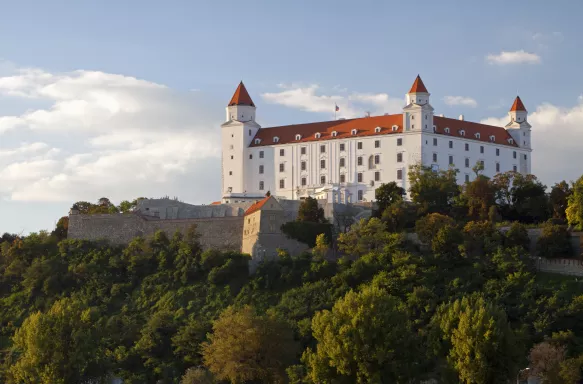
Esztergom
Once the first capital of Hungary and the birthplace of its founding king, St. Stephen I, Esztergom holds a proud place in the nation’s history. St. Stephen established the city as the center of the Catholic Church in Hungary, a legacy that continues to define its identity today. Over the centuries, Esztergom has evolved into both an ecclesiastical hub and a popular cultural destination, offering travelers on a Danube river cruise a fascinating glimpse into Hungary’s spiritual heart.
Dominating the skyline is the awe-inspiring Esztergom Basilica, one of the largest churches in Europe and home to one of the world’s biggest altarpieces. Its vast neoclassical dome and collection of priceless religious artifacts make it an unforgettable stop for anyone exploring the best European river cruise routes.
Just a short walk away, near the banks of the Danube River, stand the remnants of Esztergom Castle, perched high on a hill overlooking the town. Originally built as a royal palace by French architects in the 12th century, the site flourished during Esztergom’s golden age. Today, it houses the Castle Museum, a fascinating blend of medieval and modern architecture that tells the story of Hungary’s royal past through displays of ancient pottery, coins, weapons, and carved stonework.
For those sailing the Danube cruise route between Vienna and Budapest, Esztergom offers a perfect balance of history, architecture, and panoramic river views — a timeless highlight of any European river cruise adventure.
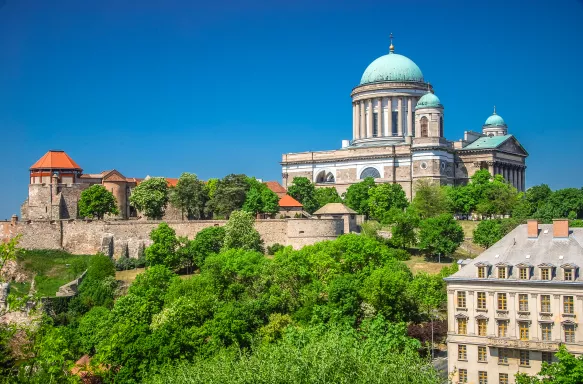
Budapest
The magnificent twin cities of Buda and Pest sit on opposite sides of the Danube River, where the rolling Buda Hills meet the vast Great Plain. This unique geography — divided yet united by the river — gives Budapest its unmistakable charm and makes it one of the most captivating stops on any Danube river cruise.
The city’s history is as rich as its architecture. The legacy of Ottoman rule endures in Budapest’s famous thermal baths, including the centuries-old Rudas Baths and Veli Bej Baths, which date back to the 16th century. After the Ottoman era, Budapest flourished under the Habsburg Empire, transforming into a glittering imperial capital filled with grand boulevards, palaces, and cultural landmarks — a legacy recognized with UNESCO World Heritage Site status in 1987.
A visit to the Buda Castle District reveals the city at its most enchanting. The majestic Royal Palace (Buda Castle) crowns Várhegy Hill, offering panoramic views over the Danube and the Pest skyline. Beneath it lies the mysterious Labyrinth, which has served over the centuries as a shelter, prison, hospital, and even a Turkish harem. Nearby, the fairy-tale Fisherman’s Bastion, built in the 19th century, provides some of the best photo opportunities in Budapest, while the magnificent Matthias Church — the coronation site of Hungarian kings — stands as a symbol of the nation’s royal heritage.
As the second-largest city on the Danube, Budapest offers endless experiences for every traveler: world-class museums, art galleries, striking architecture, and vibrant shopping streets. Whether soaking in a thermal bath, admiring the illuminated bridges by night, or exploring its historic heart, Budapest perfectly embodies the grandeur and romance of a European river cruise — and is an essential highlight of the best Danube river cruises through Central Europe.
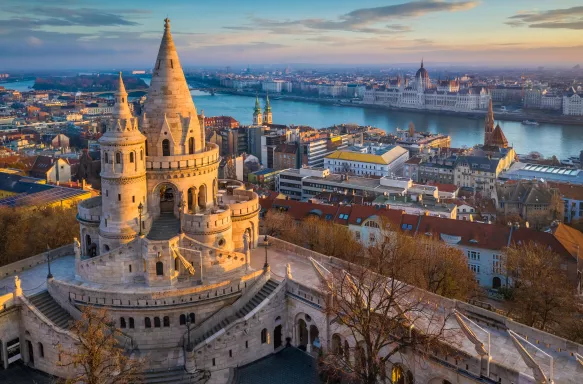
We visit Linz, Salzberg, Melk, Durstein, Vienna, Bratislava, Esztergom and Budapest on The Blue Danube river cruise.
View all river cruises in Hungary
Belgrade
The vibrant Serbian capital of Belgrade is the only European capital city located at the confluence of two major rivers — the Danube and the Sava — making it a standout destination on any Danube river cruise. With a history stretching back to 400 BC, Belgrade has been shaped by empires and battles, resulting in a fascinating blend of cultures, influences, and architectural styles.
Once expanded by the Romans and later besieged over a hundred times, Belgrade carries the marks of its complex past in its streets and skyline. The city is best explored on foot, where you’ll discover remnants of fortifications, Austro-Hungarian façades, and striking examples of Brutalist architecture — all telling the story of a city constantly reborn.
Science enthusiasts will appreciate a visit to the Nikola Tesla Museum, dedicated to one of Serbia’s greatest minds. The museum’s engaging exhibits celebrate Tesla’s revolutionary inventions and enduring legacy, offering a unique glimpse into the history of modern science.
Just beyond the city center lies Ada Ciganlija, a leafy peninsula transformed into Belgrade’s favorite summer retreat. Known as “Belgrade’s Seaside,” this lively recreational area is perfect for swimming, sunbathing, and water sports, surrounded by forests and wildlife that create their own microclimate.
Belgrade also brims with historical and cultural landmarks. Wander the winding streets of the Old Town, visit the majestic Church of Saint Sava — one of the largest Orthodox churches in the world — and stroll through Republic Square and Prince Michael Street, lined with ornate 19th-century buildings, many bearing the architectural imprint of the Habsburg Empire.
Dynamic, resilient, and endlessly intriguing, Belgrade is a highlight of any European river cruise and a must-see stop for travelers seeking the best Danube river cruise through Eastern Europe.
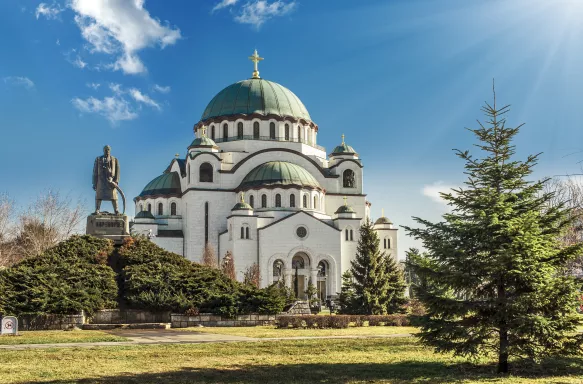
Iron Gates Gorge
Between Serbia and Romania, the Iron Gate marks one of the most dramatic and breathtaking stretches of the Danube River — a must-see highlight on any Danube river cruise. Once among the river’s most dangerous passages, this narrow gorge was tamed in the 20th century when a massive lock and dam system was constructed to control the water’s flow. The project raised the water level by over 130 feet, transforming the geography of the region and submerging entire villages beneath the surface.
Today, sailing through the Iron Gate Gorge offers an unforgettable experience. Towering cliffs rise steeply from the riverbanks, framing panoramic views of the Danube as it winds between the Carpathian and Balkan Mountains. On the Romanian side, travelers can admire one of Europe’s most remarkable landmarks — the colossal rock-carved face of Decebalus, the largest stone sculpture on a riverbank anywhere in the world.
For those exploring the best European river cruise routes, the Iron Gate represents not just a natural wonder but also a moment of quiet reflection — a striking reminder of the Danube’s immense power and the centuries of history that have unfolded along its shores.
Bucharest
Known as “Little Paris” for its grand French-style villas and tree-lined boulevards, Bucharest is Romania’s vibrant capital and the final major stop on many Danube river cruises before the river reaches the Black Sea. Once celebrated for its Belle Époque elegance, the city today offers a fascinating mix of old-world charm and striking modernity.
Dominating the skyline is the colossal Palace of the Parliament, a vast concrete structure commissioned by Communist leader Nicolae Ceaușescu. Construction began in 1984 and, astonishingly, remains unfinished. The building holds the title of the second-largest administrative building in the world, surpassed only by the Pentagon in the United States — a symbol of both ambition and excess that continues to intrigue visitors.
Bucharest also brims with cultural treasures. Among its most distinguished landmarks is the former Royal Palace, built by King Carol I after Romania became a kingdom in 1881. Today it houses the National Museum of Art of Romania, home to exquisite collections of medieval icons, modern Romanian masterpieces, and European works collected by generations of Romanian royalty.
For travelers on a European river cruise, Bucharest is more than just the end of the Danube cruise — it’s a gateway to understanding the region’s layered history, creativity, and resilience. The city’s blend of architectural splendor and cultural sophistication makes it a fitting finale to one of the best European river cruises you can take.
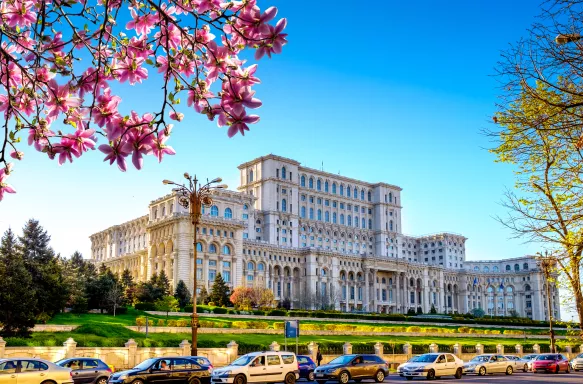
Constanta
The seaport of Constanta can trace its history back more than 2,500 years. Legend has it Constanta was visited by Jason and the Argonauts after finding the Golden Fleece. Constanta flourished during the 13th century when Genoese merchants dominated the Black Sea but the city fell into decline under Turkish rule, two centuries later. Now an important cultural and economic centre for Romania, Constanta is worth visiting for the Old Town’s architecture, its historical monuments and ancient ruins.
While most visitors pass through Constanta on their way to beach resorts in the summer, there’s plenty to see and do.
The casino here has been a landmark in Constanta for over 130 years. Built in 1910 with a billiard room, buffet and other facilities, the casino fell into disrepair during WWI and WW2 and turned into a Soviet-style Palace of culture. Abandoned since 1989, renovations have begun to restore the building to its former glory and with stunning seaside vistas, it’s a great place to take photos.
There are several museums throughout the city, including the Naval History Museum, the Natural Sciences Museum complex and the National History and Archeological Museum.
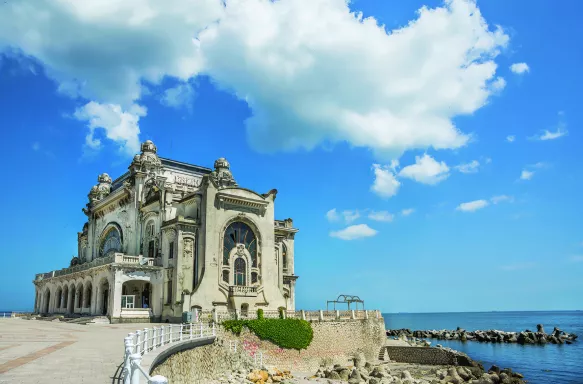
Danube Delta & Black Sea
The historic seaport of Constanța, perched on the shores of the Black Sea, marks the final chapter of many Danube river cruises. With a history stretching back more than 2,500 years, Constanța is one of Europe’s oldest continuously inhabited cities. Legend has it that Jason and the Argonauts landed here after discovering the Golden Fleece — an origin story that perfectly captures the city’s mythic allure.
Constanța flourished during the 13th century under the prosperous Genoese merchants who dominated Black Sea trade, but later declined under Ottoman rule. Today, it has reemerged as a vibrant cultural and economic center and an essential destination for travelers on a European river cruise seeking to follow the Danube from source to sea.
The city’s Old Town is rich with architectural treasures, ancient ruins, and historic monuments that tell the story of its layered past. One of its most recognizable landmarks is the Constanța Casino, an elegant Art Nouveau masterpiece that has overlooked the waterfront for more than a century. Built in 1910 as a glamorous social hub, it fell into disrepair during both World Wars before being repurposed as a Soviet-style “Palace of Culture.” Recently, restoration efforts have begun to return the casino to its former glory — and with its stunning seaside vistas, it remains a favorite spot for photography and reflection.
Constanța is also home to several engaging museums, including the National History and Archaeology Museum, the Naval History Museum, and the Natural Sciences Museum Complex, each offering insights into the region’s maritime and cultural heritage.
While many visitors pass through on their way to Romania’s Black Sea beach resorts, Constanța rewards those who linger. It’s a fitting finale to a Danube cruise — where history, legend, and the vastness of the sea converge to complete one of the best European river cruises imaginable.

We visit Budapest, Belgrade, the Daube Delta and Constana and so much more along the Danube River on our Budapest to The Black Sea river cruise.
